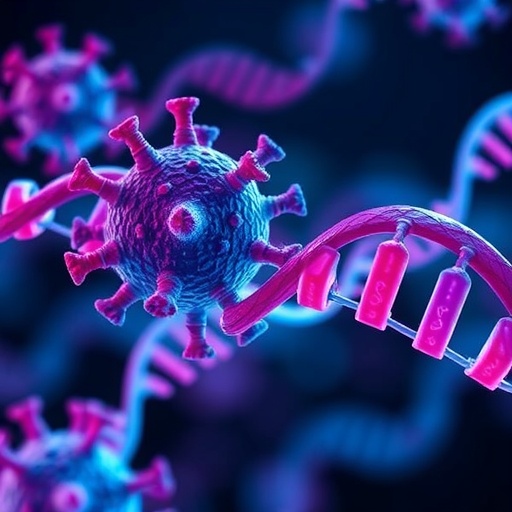In recent years, the pursuit of novel antiviral therapies has drawn significant interest from researchers across various scientific disciplines. The landscape of viral infections is constantly evolving, with emergent strains presenting formidable challenges to public health. Researchers have begun to explore innovative strategies to combat these viral pathogens, focusing on targeting specific structures within viral RNA. One such structure that has garnered attention is the RNA pseudoknot. This unique conformation plays a critical role in the life cycle of many viruses, acting as a key element in viral replication and translation processes.
The identification of small molecules that can disrupt crucial interactions within viral RNA pseudoknots may offer a pathway to novel antiviral treatments. In a groundbreaking study, Jeena et al. presented a comprehensive multi-level computational approach aimed at identifying novel RNA-binding small molecules that specifically target viral RNA pseudoknots. This research builds upon the foundational understanding of RNA structure-function relationships and highlights the potential of computational methods in drug discovery.
The team’s approach combines computational modeling, molecular dynamics simulations, and in silico screening to identify small molecules that can bind to viral RNA pseudoknots with high affinity. By leveraging advanced algorithms and vast databases of chemical compounds, the researchers are able to streamline the discovery process, significantly reducing the time and resources typically required in traditional drug development.
Central to their study is the realization that RNA pseudoknots are not merely passive structures; they have evolved to facilitate essential functions that are critical for viral persistence and propagation. The authors meticulously characterize different pseudoknot structures associated with prominent viral families, detailing their structural features and the mechanisms by which they contribute to viral fitness. This in-depth characterization underscores the importance of understanding RNA secondary and tertiary structures in the quest for effective antiviral agents.
Through their rigorous computational framework, the researchers conducted extensive screenings to evaluate the binding potential of various small molecules against target RNA pseudoknots. Each candidate underwent a series of binding affinity assessments, allowing the team to prioritize compounds with the most promising profiles for further investigation. The process reflects a shift toward a more data-driven methodology in the field of virology and pharmacology.
As the study progresses, the researchers emphasize the importance of validating their computational predictions through experimental approaches. While computational methods can provide powerful insights into molecular interactions, empirical validation remains essential for ensuring the efficacy and specificity of identified compounds. The team plans to conduct a series of biochemical assays and cellular studies to confirm the antiviral activity of their top candidates against relevant viral pathogens.
One of the compelling aspects of this research is the focus on multi-targeting strategies. The potential for RNA-binding small molecules to interact with multiple viral pathways opens exciting avenues for combination therapies. This could mitigate the risk of resistance development, a growing concern in antiviral treatment regimens. By targeting viral RNA pseudoknots, these small molecules could impair viral replication and usher in a multifaceted assault against viral propagation.
Additionally, the study highlights the convergence of bioinformatics, molecular biology, and medicinal chemistry in addressing complex virological challenges. The use of computational tools not only expedites the identification of bioactive compounds but also fosters interdisciplinary collaboration, bridging gaps between various scientific domains. The researchers advocate for more integrative approaches in the field of virology to enhance the identification and development of potent antiviral agents.
As we stand on the brink of advanced therapeutic strategies, the potential impact of this research extends beyond immediate antiviral applications. Understanding the biochemical intricacies of viral RNA could provide foundational insights that transcend individual viral species. It opens the door for the development of broad-spectrum antiviral agents that could address multiple viruses with similar RNA pseudoknot structures, thereby enhancing our preparedness against future viral outbreaks.
The findings presented by Jeena et al. represent a significant step forward in the challenging landscape of antiviral research. By harnessing the power of computational biology to target viral RNA pseudoknots, this work paves the way for innovative strategies that may soon join the antiviral arsenal. The implications for public health are profound, as new therapeutic modalities become available in the ongoing fight against viral diseases.
In conclusion, the study of targeting viral RNA pseudoknots showcases the fusion of cutting-edge technology and traditional virology to advance the field of antiviral drug discovery. As researchers continue to unravel the complexities of RNA biology, the hope is that their discoveries will lead to effective interventions that can curb the spread of viral infections and protect public health on a global scale. The quest for novel antiviral treatments is far from over, but with each advancement, the horizon of possibility expands, illuminating paths toward solutions that can safeguard future generations.
Subject of Research: Novel antiviral therapies targeting viral RNA pseudoknots.
Article Title: Targeting viral RNA pseudoknots: a multi-level computational approach to identify RNA-binding novel small molecules.
Article References: Jeena, N., CP, S.B.S., Srivastava, S. et al. Targeting viral RNA pseudoknots: a multi-level computational approach to identify RNA-binding novel small molecules. Mol Divers (2025). https://doi.org/10.1007/s11030-025-11366-5
Image Credits: AI Generated
DOI:
Keywords: Viral RNA, pseudoknots, antiviral therapies, small molecules, computational biology, drug discovery.




